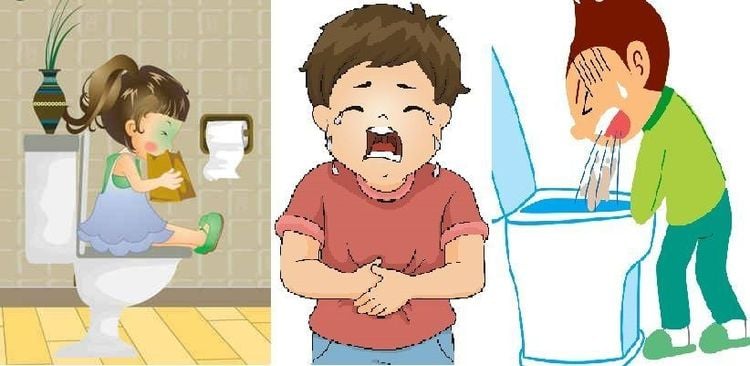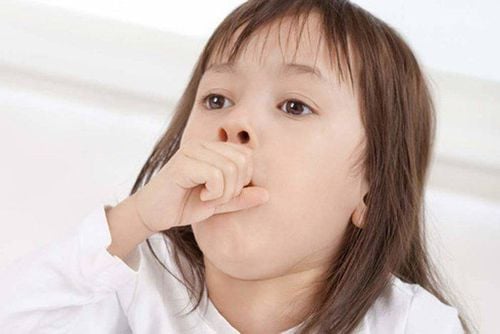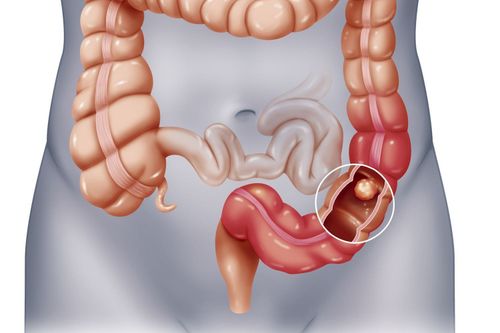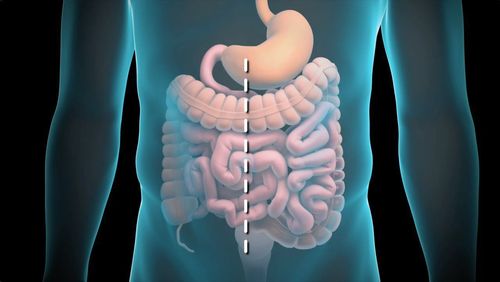This is an automatically translated article.
The article was professionally consulted by Ths.BS Nguyen Thanh Hung - Head of Pediatrics - Neonatology Department, Vinmec Nha Trang International General Hospital. Uncle has many years working in the field of General Pediatrics and Neonatology. Doctor has strengths in examination and treatment of pediatric respiratory diseases.Parents should not be subjective when the child vomits, it is necessary to monitor when the child vomits and take the baby to see a doctor as soon as there is a suspicion that the child's vomiting is an abnormal manifestation of various diseases.
1. The phenomenon of vomiting in children
Vomiting is a phenomenon in which food in the stomach is pushed up into the esophagus and then out into the mouth with pressure.Troop (a folk word) is a common phenomenon in young children and infants. This term is often referred to as gastroesophageal reflux, where milk or food can come out of the corner of the mouth. In the United States, 50% of babies under 3 months and about 67% of 4-month-olds have "poor" at least once a day.
Trắc nghiệm: các chỉ số cần chú ý về sự phát triển thể chất của trẻ
Chiều cao, cân nặng của bé ở từng giai đoạn nên là bao nhiêu là bình thường, bao nhiêu là bất thường? Cùng ThS.BS Ma Văn Thấm điểm lại xem bạn đã nắm được các chỉ số phát triển thể chất của bé chưa nhé!The following content is prepared under supervision of Thạc sĩ, Bác sĩ y khoa, Ma Văn Thấm , Nhi , Phòng khám Đa khoa Quốc tế Vinmec Dương Đông(Phú Quốc)
2. Causes of vomiting in young children
2.1. As mentioned above, most cases of "prolapse" are usually not pathological, so they can be treated at home, parents need to be explained clearly to avoid excessive worry, and at the same time note two issues: Key to home treatment: Child position and nutrition.
Position
Should have the child lie down with the head 30 degrees high. Hold the baby up for 30 minutes after feeding. Do not wear clothes that are too tight. Nutrition
Split the amount of milk. Babies should not be breastfed immediately after spitting up. Hypoallergenic formula can be given to infants for about 2 weeks if a milk allergy is suspected. Signs needing hospitalization
The child has apnea, cyanosis. Breathe fast, concave a lot. Wheezing or persistent cough. The stool is accompanied by blood or yellow, green discharge. Slow weight gain, fussy crying a lot.

2.2. Vomiting due to pathology Vomiting can be a manifestation of gastrointestinal disease or can also be a symptom of respiratory disease or systemic disease. Some diseases that cause vomiting in children and their signs:
● Gastroenteritis caused by viruses or bacteria and food poisoning: This is the most common cause of vomiting in children.
It is difficult to distinguish viral and bacterial gastroenteritis from food poisoning because the onset of the disease is quite similar: the child vomits continuously every 5 - 30 minutes in the first 12 hours.
However, there are still some signs to distinguish these two diseases:
- Gastritis caused by a viral infection has a sudden onset, vomiting, high fever and abdominal pain. Vomiting can last up to 3 days. Children with diarrhea usually appear on the first or second day.
- In case of food poisoning, the disease begins 2-12 hours after eating poor quality food. Vomiting occurs several hours after ingestion of unsafe food and usually does not last more than 12 hours. Children usually do not have a fever and may or may not have diarrhea.
Intestinal obstruction : This is a rare but very dangerous disease. The most obvious symptom of intestinal obstruction is severe abdominal pain, in addition, the child also has other symptoms such as vomiting yellow green bile, vomiting, pale, sweating ... Urinary tract infection: If the mother sees If your child has a high fever and vomits for a few days, has burning pain when urinating, or has an unpleasant odor, you should think that your baby may have a urinary tract infection Intussusception: In children under 4 years of age, vomiting can be a sign of intussusception. Some other accompanying symptoms are that the baby often bends his legs towards the abdomen, loose stools, there may be blood in the stools. If you have this disease, your baby needs emergency treatment because it is very dangerous. Hypertrophic pyloric stenosis: For babies from 3 to 5 weeks old with symptoms of severe vomiting many times, the child keeps sucking and vomiting and then hungry again and again, mothers need to think that the baby may have hypertrophic stenosis. pyloric. Children with this disease need surgery. Cough, cold, respiratory infection: Children often vomit after a severe cough.

3. What should parents do when the baby vomits?
Baby vomiting a lot often leads to dehydration, so parents need to avoid dehydration by giving them Oresol in divided doses or spoons.
Break up meals, feed your baby into several meals. Stroking the baby's back after eating and limiting the baby's running, jumping and playing for at least 20 minutes after eating. Give your baby plenty of rest. If after 12-24 hours, the baby's condition is stable, the mother can feed the baby on a normal diet again. Absolutely do not give children antiemetic drugs without a doctor's prescription.
4. When do you need to take your baby to the doctor?
Children with vomiting need to be taken to reputable facilities for medical examination and treatment when:
There are gestures of loss of consciousness; high fever, headache, stomach cramps. There are signs of dehydration (dry mouth, little urine) or parents suspect the child has food poisoning. Vomiting blood or bile. The child is lethargic or in a state of excitement. Convulsions . Persistent regurgitation or continued regurgitation for more than 24 hours. Vomiting can be a physiological manifestation that occurs in infants, however, if this condition persists and affects the health of the baby, parents need help from a doctor to examine and check the body. Identify the cause of the disease early, avoid bad consequences.
In Vietnam today, 7 out of 10 children under 5 years old have zinc deficiency and 8 pregnant women have zinc deficiency. The prevalence of zinc deficiency in pregnant women is 80.3%, women of childbearing age 63.6% and children under 5 years old is 69.4%. The most common manifestations of zinc deficiency in children are growth retardation, mild and moderate malnutrition, delayed growth in height, and some observable symptoms such as anorexia or decreased appetite, decreased suckling, and no meat. fish, slow digestion, mild constipation, persistent nausea and vomiting in children. In addition to reasonable zinc supplementation, parents also need to provide their children with other important vitamins and minerals such as lysine, chromium, B vitamins,... resistance to minor illnesses and less digestive problems.
Please regularly visit the website vimec.com and update useful information to take care of your baby and family.















